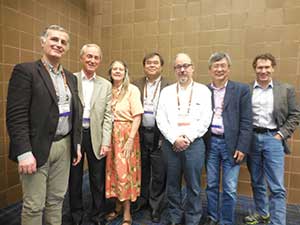Open for Business: FIP Invited Session Describes New Light Sources
By Cherril Spencer, FIP Chair 2017
The FIP invited session at the 2017 March meeting (X40 Division of Physics of Beams and Forum on International Physics Introduce the World’s Newest Light Sources) introduced four new X-ray light sources to the condensed matter-, bio and chemical-physicists who attended the March meeting, so that they could evaluate if they could use the X-rays produced by these new machines in their research. The first of the five speakers was Richard Walker of the Diamond Light Source in England who gave a comprehensive “Overview of New Synchrotron Radiation and Free Electron Laser Light Sources” which included the history of light sources, starting with the chance discovery of synchrotron radiation in 1947 at a commercial synchrotron. The “brightness” of the synchrotron radiation is the figure of merit one uses to judge the intensity and collimation of the X-rays produced by the electrons in “light” sources. Walker described the progression in the types of magnets within which the electrons are forced to emit photons, from single bending magnets, to double bend achromats (DBA) to multiple bend achromats (MBA), and how the brightness has improved with these changes; the reduction in the electron beam’s emittance has also led to brighter sources. The “free electron laser” (FEL) is another type of electron accelerator (linear rather than circular) that produces X-rays, using a series of adjacent bending magnets in a so-called undulator.
The other four speakers described the new light sources that they direct and the types of X-rays their newly-commissioned synchrotrons and FEL produce and how to apply for beam-time. Di-Jing Huang of the National Synchrotron Radiation Research Center described the Taiwan Photon Source (TPS). It is a low-emittance 3 GeV storage ring-based synchrotron light source with a circumference of 518 m and is composed of 24 double-bend achromatic (DBA) cells connected by six 12-m straight sections and eighteen 7-m straight sections. Seven phase-I beamlines have an energy range from soft to hard X-rays and are optimized for protein micro-crystallography, low-energy excitations of novel materials with atomic specificity, spectroscopy and diffraction on the submicron and nanometer scales, scattering of coherent X-rays, and scanning nanoprobe studies that will resolve structures with a spatial resolution of tens of nanometers. All phase-I beamlines are available to users in 2017.
Pedro Fernandes Tavares of the MAX IV Laboratory, Lund University, Sweden, described the MAX IV light source which is being commissioned and marks the dawn of a new generation of storage-ring-based light sources. It is also based on a 3GeV storage ring and its use of 7-bend achromats delivers orders-of-magnitude higher performance and allows realization of groundbreaking experiments on a variety of systems and materials at the atomic and molecular levels. Tavares described the important features of the MAX IV machine including the small apertures of all the magnets and the unusual design of the vacuum chambers. The commissioning is continuing and the Tavares is confident the final design specs will be met. There are 14 X-ray beamlines available to be used to do a wide variety of experiments, such as high pressure photoelectron spectroscopy (HIPPIE) and macromolecular crystallography with a high degree of automation and remote access (bioMAX). Tavares’ slides can be viewed at https://absuploads.aps.org/presentation.cfm?pid=13398.
The fourth speaker in this session, In Soo Ko, of the Pohang University of Science and Technology in Korea, described their very new free electron laser: PAL-XFEL, based on a 10 GeV electron normal-conducting linac. Its goal is to produce 0.1 nm coherent X-ray laser to photon beam users. The project was started in April 2011, the building of the 1.11km-long accelerator housing and the installation of the linac components, undulator systems, beamlines and experimental hutches was completed by the end of 2015. The commissioning of the XFEL was going well in 2016 when an earthquake followed by a typhoon three weeks later caused 2 disruptions, but the hard-working team got everything re-aligned and they achieved 0.144 nm saturation on November 27th 2016. They called in February 2017 for proposals to use some of the hard and soft X ray lines and received 22 proposals requesting 125 12-hour long shifts, which is many more than the 43 shifts available for early-beam users. Potential applications of ultra-short pulsed, coherent X-rays will be structural molecular biology and ultra-fast chemical dynamics in the range of femtoseconds. Ko’s slides can be viewed at https://absuploads.aps.org/presentation.cfm?pid=13345
The last speaker, Giorgio Paolucci, in this session brought us to the Middle East and an unusual collaboration of 9 countries who have built a 2.5 GeV storage ring for producing synchrotron radiation, they are Bahrain, Cyprus, Egypt, Iran, Israel, Jordan, Pakistan, Palestinian Authority and Turkey. The project is called SESAME: Synchrotron-light for Experimental Science and Applications in the Middle East. As well as providing X-rays for materials science and biochemical experiments SESAME has other objectives: (a) foster excellence in science and technology in the Middle East, (b) reverse brain drain in the region, (c) enhance regional science and technology infrastructure and (d) contribute to improved understanding among peoples of diverse backgrounds through peaceful scientific cooperation; which are all being met. SESAME has received new and recycled equipment and technical assistance from many established labs such as ALBA, CERN, ESRF, INFN and MAXIV. The commissioning of the storage ring started in late 2016 and the first stored beam was achieved on February 9, 2017, progress is being made weekly and 5 beam-lines are ready to receive various types of X-rays. Paolucci’s slides can be viewed here: https://absuploads.aps.org/presentation.cfm?pid=13284
This session was informally co-sponsored with the Division of the Physics of Beams (DPB).

Five speakers and session chairs, from left to right: Paolucci, Walker, Cherrill Spencer (FIP Chair), Huang, Tavares, Ko and Tor Raubenheimer (DPB Chair).
